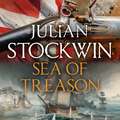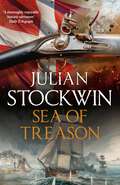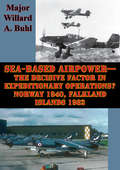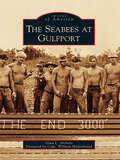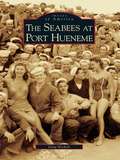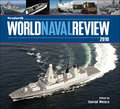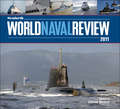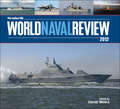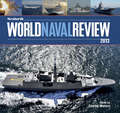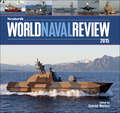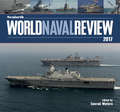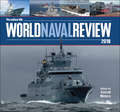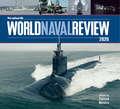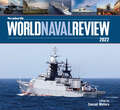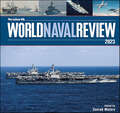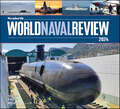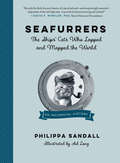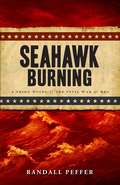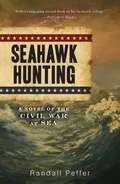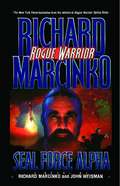- Table View
- List View
Sea of Treason: Thomas Kydd 26 (Thomas Kydd #53)
by Julian StockwinThe 26th Kydd adventure from veteran writer Julian Stockwin.Following his recovery after a savage wounding in America, Kydd returns to England to re-assume command of his ship-of-the-line, Thunderer, which is sent to the remote station of Bermuda.'Paints a vivid picture of life aboard the mighty ship-of-the-line' Daily Express(P)2023 Hodder & Stoughton Limited
Sea of Treason: Thomas Kydd 26 (Thomas Kydd #53)
by Julian StockwinFollowing his recovery after a savage wounding in America, Kydd returns to England to re-assume command of his ship-of-the-line, Thunderer, which is sent to the remote station of Bermuda.'Paints a vivid picture of life aboard the mighty ship-of-the-line' Daily Express
Sea of Treason: Thomas Kydd 26 (Thomas Kydd #53)
by Julian StockwinFollowing his recovery after a savage wounding in America, Kydd returns to England to re-assume command of his ship-of-the-line, Thunderer, which is sent to the remote station of Bermuda.'Paints a vivid picture of life aboard the mighty ship-of-the-line' Daily Express
Sea-Based Airpower—The Decisive Factor In Expeditionary Operations? Norway 1940, Falkland Islands 1982
by Major Willard A. BuhlThis essay examines the British use of sea-based aviation in support of two modern amphibious campaigns: the British campaign in Norway in 1940 and in the Falkland Islands War in 1982. The purpose is to determine whether or not aircraft carriers (sea-based aviation) were at the root of the success or failure of British efforts.In April 1940, there were no airfields in central Norway capable of supporting modern, high performance aircraft. As the Norwegian campaign unfolded and the British faced a significant land-based air threat from the Luftwaffe, they failed to appreciate the tactical and operational potential of sea-based aviation. At the same time, British naval aircraft were technically inferior in design and capability compared to their Luftwaffe land-based counterparts in 1940. Nevertheless, despite determined attacks on British naval assets at the tactical level, at the operational level, the German command limited their campaign goals and did not exploit their advantage in the air to the extent possible. Their actions did, however, place great pressure on British sea based lines of communication in central Norway, the operational pivot of the campaign.In 1982, against the Argentines, the British faced another opponent with superior land-based aviation. Although the British fully appreciated the need for air superiority, they employed a tactical scheme not unlike what had occurred in Norway. Nevertheless, the British were able to successfully contest the airspace above the Falklands and ultimately succeeded in defeating Argentine ground forces and ejecting them from the islands.
Seabees at Gulfport, The (Images of America)
by Capt. William Hilderbrand Gina L. NicholsIn June 1942, the U.S. Navy established an advance base depot in Gulfport because of its uncrowded deepwater port, rail access, open land, and a tepid climate that permitted training and open port facilities year-round. The base became the southern home for the Seabees and was ideal for shipping construction materiel and men to the Caribbean or the Pacific via the Panama Canal. Since the base reopened in March 1966, Seabees have deployed from Gulfport to serve during major conflicts as well as in peacetime. Seabees from Gulfport played an integral part in Operation Desert Shield/Desert Storm and more recently deployed to Afghanistan and Iraq to assist in local construction efforts to rebuild both countries. Seabees assist thousands each year in international humanitarian projects while still calling Gulfport home.
Seabees at Port Hueneme, The (Images of America)
by Gina NicholsIn 1942, the navy sought a location for an advance base on the West Coast to ship construction materiel, equipment, and men into World War II's Pacific theater. Port Hueneme's deepwater harbor, rail system, and rural setting made it the ideal site from which to send 20 million measurement tons of war materiel and a quarter of a million men onto island specks that later became headlines: Guadalcanal, Tarawa, Iwo Jima, Okinawa, and the Philippines. Seabees later deployed from Port Hueneme to serve in the Korean, Vietnam, Desert Shield/Desert Storm, and Iraqi conflicts, as well as in peacetime, for more than 60 years. Charged with building air bases, ports, combat camps, hospitals, and other support facilities as part of military and humanitarianefforts around the world, the Seabees remain at home in Port Hueneme.
Seaford and Eastbourne in the Great War (Your Towns & Cities in the Great War)
by Kevin GordonHow the experience of war impacted on the town, from the initial enthusiasm for sorting out the German kaiser in time for Christmas 1914, to the gradual realization of the enormity of human sacrifice the families of Seaforth and Eastbourne were committed to as the war stretched out over the next four years. A record of the growing disillusion of the people, their tragedies and hardships and a determination to see it through. The Sussex seaside towns of Seaford and Eastbourne were closer to the action than most places; the sound of naval battles could be heard from the coast (and sometimes witnessed by those with a good pair of binoculars). When the wind was in the right direction the rumble of artillery from France bought the frontline into the streets. At the start of the Great War, Eastbourne was an elegant and blossoming resort and did its best to maintain its tourist trade despite the arrival of soldiers, aeroplanes, refugees and the wounded. Seaford was a much smaller resort with a population of under 4,000 however thousands of troops from all over the Empire were billeted in the area either at private homes or in two massive camps. The Seaford camps were the venue for training, parades, fighting, murder and even rioting. Nearby Newhaven became an important port in which provisions were transported to the front. Conscientious Objectors, some under threat of the death penalty worked on the docks and the nearby roads. In his book Seaford and Eastbourne in the Great War local historian, Kevin Gordon tells the story of how the conflict affected, not only these seaside towns but also of the soldiers (many of them teenagers) who answered the call to battle. It is a story of spies, schoolchildren and sacrifice; a story that, for many, ended in the cemetery at Seaford which today is one of the largest Commonwealth War Graves in the South of England.
Seaforth World Naval Review 2010
by Conrad WatersThe World Naval Review is designed to fill the need for an authoritative but affordable summary of all that has happened in the naval world in the previous twelve months. It combines the standing features of regional surveys with one-off major articles on noteworthy new ships and other important developments. Besides the latest warship projects, it also looks at wider issues of importance to navies, such as aviation and electronics, and calls on expertise from around the globe to give a balanced picture of what is going on and to interpret its significance. Intended to make interesting reading as well as providing authoritative reference, there is a strong visual emphasis, including specially commissioned drawings and the most recently released photographs and artists' impressions.For anyone with an interest in contemporary naval affairs, whether an enthusiast or a defence professional, this annual is set to become required reading.
Seaforth World Naval Review 2011: 2011
by Conrad WatersLaunched in 2009, this annual is rapidly establishing a reputation as an authoritative but affordable summary of all that has happened in the naval world in the previous twelve months. It combines the standing features of regional surveys with one-off major articles on noteworthy new ships and other important developments. Besides the latest warship projects, it also looks at wider issues of importance to navies, such as aviation and electronics, and calls on expertise from around the globe to give a balanced picture of what is going on and to interpret its significance. This year special features include in-depth studies of the growing naval power of Turkey and South Korea, plus analyses of four significant new warship classes: the RN's Astute class nuclear attack submarines; India's Project 15 destroyers; the Norwegian Fridtjof Nansen, the smallest warship to carry the Aegis weapon system; and USS Independence, an innovative littoral combat ship designs.Intended to make interesting reading as well as providing authoritative reference, there is a strong visual emphasis, including specially commissioned drawings and the most recently released photographs and artists' impressions.For anyone with an interest in contemporary naval affairs, whether an enthusiast or a defence professional, this annual is set to become required reading.
Seaforth World Naval Review 2012
by Conrad WatersLaunched in 2009, this annual has rapidly established a reputation as an authoritative but affordable summary of all that has happened in the naval world in the previous twelve months. It combines the standing features of regional surveys with one-off major articles on noteworthy new ships and other important developments. Besides the latest warship projects, it also looks at wider issues of importance to navies, such as aviation and electronics, and calls on expertise from around the globe to give a balanced picture of what is going on and to interpret its significance. This year special features include in-depth studies of the navies of Brazil, Australia and Pakistan, plus analyses of three significant new warship classes: the USNs advanced amphibious warfare ship Makin Island (LHD-8): Swedens futuristic Visby class stealth corvettes; and the BAE Systems offshore patrol vessels.Intended to make interesting reading as well as providing authoritative reference, there is a strong visual emphasis, including specially commissioned drawings and the most recently released photographs and artists impressions. For anyone with an interest in contemporary naval affairs, whether an enthusiast or a defense professional, this annual has become required readin
Seaforth World Naval Review 2013
by Conrad Waters&“The 2013 edition . . . includes four articles on significant ships, respectively; French Navy, US Coast Guard, German Navy and Indian Navy.&”—Firetrench Reviews Launched in 2009, this annual has rapidly established a reputation as an authoritative but affordable summary of all that has happened in the naval world in the previous twelve months. It combines the standing features of regional surveys with one-off major articles on noteworthy new ships and other important developments. Besides the latest warship projects, it also looks at wider issues of importance to navies, such as aviation and electronics, and calls on expertise from around the globe to give a balanced picture of what is going on and to interpret its significance. Special features for the 2013 edition include in-depth studies of the navies of Italy and Ireland, plus analyses of significant new warship classes: the French Aquitaine class frigates, Indian Shivalik class Project 17 frigates, German Braunschweig class corvettes, and US Bertholf class national security cutters. Intended to make interesting reading as well as providing authoritative reference, there is a strong visual emphasis, including specially commissioned drawings and the most recently released photographs and artists&’ impressions. This annual has become &“a must for those wishing to keep up with world naval affairs&” (Scuttlebutt).
Seaforth World Naval Review 2015: 2015
by Conrad WatersThe &“profusely illustrated&” yearly military reference that features world fleet reviews, significant ship developments, and technological advancements (Ships Monthly). Now in its seventh year, this annual has established an international reputation as an authoritative but affordable summary of all that has happened in the naval world in the previous twelve months. It combines regional surveys with one-off major articles on noteworthy new ships and other important developments. Besides the latest warship projects, it also looks at wider issues of importance to navies, such as aviation and electronics, and calls on expertise from around the globe to give a balanced picture of what is going on and to interpret its significance. The 2015 edition looks in detail at the French Navy and the Bangladesh and Myanmar navies, while significant ships include the Montford Point class mobile landing platforms, the Samuel Beckett offshore patrol vessels, and the Skjold class fast attack craft. There are technological reviews dealing with naval aviation by David Hobbs, and current mine warfare developments by Norman Friedman, while warship recycling is discussed by Ian Buxton. Intended to make interesting reading as well as providing authoritative reference, there is a strong visual emphasis, including specially commissioned drawings and the most up-to-date photographs and artists&’ impressions. For anyone with an interest in contemporary naval affairs, whether an enthusiast or a defense professional, this annual has become required reading.
Seaforth World Naval Review 2016
by Conrad Waters&“The crème de la crème of naval writers . . . an extremely detailed overview of the last year in naval policy, construction and deployment.&”—Warship World This annual has an established reputation as an authoritative but affordable summary of all that has happened in the naval world in the previous twelve months. It combines regional surveys with one-off major articles on noteworthy new ships and other important developments. Besides the latest warship projects, it also looks at wider issues of importance to navies, such as aviation and electronics, and calls on expertise from around the globe to give a balanced picture of what is going on and to interpret its significance. This edition looks in detail at the Royal Navy as it faces the latest defense review, and evaluates the Indonesian Navy, while significant ships will include the USN&’s San Antonio class amphibious transports, the new Dutch OPVs, the Turkish Milgem class corvettes and the Greek Roussen class fast attack craft. There are also technological reviews dealing with naval aviation by David Hobbs, focusing on maritime patrol aircraft, while Norman Friedman surveys recent electronic warfare developments. Intended to make interesting reading as well as providing authoritative reference, there is a strong visual emphasis, including specially commissioned drawings and the most up-to-date photographs and artists&’ impressions. For anyone with an interest in contemporary naval affairs, whether an enthusiast or a defense professional, this annual has become required reading. &“A high-quality, deeply-researched and handsomely-illustrated book.&”—Army Rumour Service
Seaforth World Naval Review 2017
by Conrad Waters&“This fascinating book examines trends in maritime strategy and geopolitics . . . including technological advances and significant new ships.&”—Nautilus Telegraph This annual has an established reputation as an authoritative but affordable summary of all that has happened in the naval world in the previous twelve months. It combines regional surveys with one-off major articles on noteworthy new ships and other important developments. Besides the latest warship projects, it also looks at wider issues of importance to navies, such as aviation and electronics, and calls on expertise from around the globe to give a balanced picture of what is going on and to interpret its significance. Features of this edition include an in-depth analysis of the Royal Netherlands Navy, while Significant Ships will cover the USN&’s radical new Zumwalt class destroyers, the Republic of Korea&’s amphibious assault ship Dokdo, and the JMSDF&’s Akizuki class destroyers, among others. There are also technological reviews dealing with naval aviation by David Hobbs (with a focus on the present state of the RN&’s Fleet Air Arm), while Norman Friedman surveys naval surface-to-surface missiles. The World Naval Review is intended to make interesting reading as well as providing authoritative reference, so there is a strong visual emphasis, including specially commissioned drawings and the most up-to-date photographs and artists&’ impressions. For anyone with an interest in contemporary naval affairs, whether an enthusiast or a defense professional, this annual has become required reading. &“An extraordinarily useful annual from the point of view of a comprehensive update on the world&’s navies . . . a key resource for keeping up, whether in cabin or armchair.&”—Seaweed
Seaforth World Naval Review 2018: 2018
by Conrad WatersThe yearly military reference that&’s &“a well written, easy to read and well illustrated discussion of current naval power world-wide&”—Thomo&’s Hole. Now firmly established as an authoritative but affordable summary of all that has happened in the naval world in the previous twelve months, this annual combines regional surveys with one-off major articles on noteworthy new ships and other important developments. Besides the latest warship projects, it also looks at wider issues of importance to navies, such as aviation and weaponry, and calls on expertise from around the globe to give a balanced picture of what is going on and to interpret its significance. Features of this edition include an analysis of the Republic of Korea Navy and the response to its aggressive northern neighbor. Significant Ships will cover the USN&’s revamped Arleigh Burke class destroyer design, German F125 class frigates, and the RNZN&’s Otago class offshore patrol vessels. There are also technological reviews dealing with naval aviation by David Hobbs, RN missile programs by Richard Scott, while Norman Friedman turns his attention to new generation weapons technology. The World Naval Review is intended to make interesting reading as well as providing authoritative reference, so there is a strong visual emphasis, including specially commissioned drawings and the most up-to-date photographs and artists&’ impressions. For anyone with an interest in contemporary naval affairs, whether an enthusiast or a defense professional, this annual has become required reading.
Seaforth World Naval Review 2020
by Conrad WatersThis anthology features in-depth assessments of naval innovations and developments around the word by leading experts in the field. The Seaforth World Naval Review 2020 provides an authoritative summary of cutting-edge naval developments across the globe. Regional surveys of fleet evolution and procurement by editor Conrad Waters are supplemented by in-depth articles from a range of experts focusing on significant new warships, technological advances and specific navies. This volume features coverage of the US Navy&’s Virginia class submarines, the Royal Navy&’s Tide class tankers and the Indian P28 Komorto class corvettes. Recent developments in submarine technology are analyzed by Norman Friedman, while David Hobbs&’ usual review of naval aviation focusses on the F35 Lightning II. In-depth fleet reviews look at Finland and Germany and analyze how they are responding to the increased Russian threat. Now firmly established as providing the only annual naval overview of its type, The Seaforth World Naval Review is essential reading for anyone interested in contemporary maritime affairs.
Seaforth World Naval Review 2020
by Conrad WatersThis anthology features in-depth assessments of naval innovations and developments around the word by leading experts in the field. The Seaforth World Naval Review 2020 provides an authoritative summary of cutting-edge naval developments across the globe. Regional surveys of fleet evolution and procurement by editor Conrad Waters are supplemented by in-depth articles from a range of experts focusing on significant new warships, technological advances and specific navies. This volume features coverage of the US Navy&’s Virginia class submarines, the Royal Navy&’s Tide class tankers and the Indian P28 Komorto class corvettes. Recent developments in submarine technology are analyzed by Norman Friedman, while David Hobbs&’ usual review of naval aviation focusses on the F35 Lightning II. In-depth fleet reviews look at Finland and Germany and analyze how they are responding to the increased Russian threat. Now firmly established as providing the only annual naval overview of its type, The Seaforth World Naval Review is essential reading for anyone interested in contemporary maritime affairs.
Seaforth World Naval Review 2021
by Editor Conrad WatersThe essential compendium covering the year in naval developments—the only annual overview of its kind.For over a decade, this annual has provided an authoritative summary of all that has happened in the naval world in the previous twelve months, combining regional surveys with major articles on noteworthy new ships and other important developments. Besides the latest warship projects, it also looks at wider issues of significance to navies, such as aviation and weaponry, and calls on expertise from around the globe to give a balanced picture of what is going on and to interpret its significance.The latest of the in-depth “Significant Ships” series cover the US Navy’s America (LHA-6) class amphibious ships; the Singaporean Independence, an indigenous design of Littoral Mission Vessel; and the venerable Type 23 frigate, still the mainstay of the British Royal Navy’s surface fleet. Technological subjects include an analysis of stealth at sea by Norman Friedman, the US Standard missile family by Richard Scott, as well as David Hobbs’ regular review of naval aviation. This year the reviews of specific fleets focus on the navies of Sweden and Nigeria, two medium sized naval powers with very different histories.Firmly established as the only annual naval overview of its type, World Naval Review is essential reading for anyone—whether enthusiast or professional—interested in contemporary maritime affairs.
Seaforth World Naval Review 2022: 2022
by Conrad WatersFor more than a decade, this annual volume has provided an authoritative summary of all that has happened to the world's navies and their ships in the previous twelve months. It combines regional surveys with major articles on important new warships, and looks at wider issues of significance to navies such as aviation and weaponry. The contributors come from around the globe and as well as providing a balanced picture of naval developments, they interpret their significance and explain their context. As well as its regular regional reviews, the 2022 volume focuses on three fleets: the Sri Lankan Navy, the Spanish Navy, and the Royal Navy. There are in-depth articles on the Argentinian Bouchard Class OPVs, the Russian Project 20380 Stereguschchiy Class corvettes, and the Royal Navy's Batch 2 'River' Class OPVs. The technological section looks at optronic systems and offboard mine countermeasures, and there is the regular review of what is happening in naval aviation, which includes coverage of the US Marine/Navy MV-22 tiltrotor. Now firmly established as the only annual naval overview of its type in the world, The Seaforth World Naval Review is essential reading for the professional and enthusiast alike. It takes the reader to the heart of contemporary maritime affairs. "…this is a marvelous asset for those wishing to keep up to date with naval matters. Very highly recommended." - Warship World
Seaforth World Naval Review 2023
by Conrad WatersFor over a decade this annual has provided an authoritative summary of all that has happened in the naval world in the previous twelve months, combining regional surveys with one-off major articles on noteworthy new ships and other important developments. Besides the latest warship projects, it also looks at wider issues of significance to navies, such as aviation and weaponry, and calls on expertise from around the globe to give a balanced picture of what is going on and to interpret its significance. As 2022 saw the outbreak of the first major European war since 1945, it is not surprising that the naval aspects of the conflict in Ukraine take center stage, with an interim assessment of the fighting so far and what can be gleaned of the strategies and tactics of the warring parties. Another newsworthy topic – hypersonic missiles – is the subject of Norman Friedman’s expert analysis. Of the regular features, the ‘Significant Ships’ cover the US Navy’s Nimitz class carriers, now representing fifty years of evolution; and HMNZS Aotearoa, the largest warship built for New Zealand. Of the Fleet Reviews, one looks at the US Navy’s adaptation to the return of Great Power competition, not least with China, and the second covers the Vietnam People’s Navy, which faces Chinese pressure at close quarters. Firmly established as the only annual naval overview of its type, World Naval Review is essential reading for anyone – whether enthusiast or professional – interested in contemporary maritime affairs.
Seaforth World Naval Review 2024
by Conrad WatersFor more than a decade this annual volume has provided an authoritative summary of all the developments in the world's navies and their ships in the previous twelve months. It combines regional surveys with major articles on important new warships, and looks at wider issues of significance to navies such as aviation and weaponry. The contributors come from around the globe and as well as providing a balanced picture of naval developments, they interpret their significance and explain their context. As well as its regular regional reviews, the 2024 volume focusses on three fleets: the Brazilian Navy, the Hellenic Navy and the Royal Navy. There are in-depth articles on the French Auguste Benebig class of overseas patrol vessels, the Indian P15A & P15B Kolkata/Visakhapatnam class destroyers, and the Spanish S-80 Class Isaac Peral class submarines. The third regular section of the volume is devoted to reviews of important technological developments around the world. David Hobbs looks at aspects of naval aviation and focusses on US unmanned systems. Norman Friedman outlines developments in naval propulsion systems, while Richard Scott analyzes the Kongsberg/Raytheon naval strike missile. Now firmly established as the only annual naval overview of its type in the world, The Seaforth World Naval Review is essential reading for professional and enthusiast alike. It takes the reader to the heart of contemporary maritime affairs. '…this is a marvelous asset for those wishing to keep up to date with naval matters. Very highly recommended.' - Warship World
Seafurrers: The Ships' Cats Who Lapped and Mapped the World
by Philippa SandallA cat&’s-eye view of maritime history: &“Priceless historic photographs . . . deep and wide-ranging research . . . a ball of spellbinding and hilarious sea yarns.&” —Richard J. King, author of Ahab&’s Rolling Sea: A Natural History of &“Moby-Dick&” We remember the bold seafarers of yore—from Magellan to Shackleton—for their extraordinary exploits: new lands discovered, storms weathered, and battles won. But somehow history has neglected the stalwart, hardworking species who made it all possible . . . yes, the noble cat! In Seafurrers, able sea cat Bart sets the record straight at last. &“Fear of water&” aside, cats were indispensable at sea—both as pest controllers and as beloved mascots. Thirty–eight tales recount the adventures of Trim (who circumnavigated Australia), Tom (the sole feline survivor of the sinking of the USS Maine), celebrity cat Simon (a veteran of the Yangtze Incident), and other furry heroes. Filled with nautical trivia, rare photographs, and whimsical illustrations, this deft genealogy of human–feline friendship will stir your regard for the incomparable cat—whether on the couch or in the crow&’s nest.
Seahawk Burning
by Randall PefferA Novel of the Civil War at SeaThis final volume in the Raphael Semmes trilogy of Civil War naval thrillers, Seahawk Burning, follows the real-life adventures of Confederate Captain Raphael Semmes and his ship, the C.S.S. Alabama, on the final legs of their reign of terror on the high seas. The novel chronicles Semmes's rise to mythic stature as he becomes Lincoln's public enemy number one, seizing and burning scores of Yankee ships in the Caribbean Sea, the south Atlantic, the Indian Ocean, and the South China Sea before heading to France for sanctuary...all the while dodging scores of federal Navy ships pursuing him.Enemy vessels, spy games, mutinies, storms, and loneliness stock Semmes's cruise during 1863-64. Meanwhile, back in the Lincoln White House, Secretary of the Navy Gideon Welles tries to marshal his warships to catch Semmes and simultaneously protect his president from spies and assassins, one of whom is Semmes's mistress.In addition to the main characters, the cast of Seahawk Burning includes historical figures from the governments and navies of the North and South as well as the Black Moses Harriet Tubman, John Wilkes Booth, and his fellow conspirators.All of the threads in this saga come together in a final showdown off Cherbourg, France, when Semmes decides to take the Alabama into battle against the U.S.S. Kearsarge, captained by his old friend John A. Winslow. It is one of the greatest naval battles in history.
Seahawk Hunting
by Randall PefferIn Seahawk Hunting Rafael Semmes abandons his broken raider, the Sumter, which is penned in by the Federals near Gibraltar. In the meantime, he has the Brits build him a new ship in Liverpool. Called the 290, it is the fastest commercial raider designed for its time, and it is waiting for Semmes in the Azores.After taking command of the ship he sets out seizing and burning whalers at the rate of one a day, sails back across the North Atlantic against the gulf stream where he picks off another dozen merchant ships headed to Europe.Then, after a thwarted attempt to sneak attack New York City, Semmes makes a beeline for Martinique in the Caribbean during the course of which he has to put down a mutiny on board and evade the USS San Jacinto which has come to destroy him. Finally, Semmes makes it to Galveston where he has an epic gun battle with the USS Hatteras.
Seal Force Alpha (Rogue Warrior #6)
by Richard MarcinkoAS A U.S. NAVY SEAL, RICHARD MARCINKO KNEW NO LIMITS -- AS THE ROGUE WARRIOR, HE OBEYS NO RULES!SpecWar master Richard Marcinko has revealed classified, kill-or-be-killed operations in a series of New York Times bestsellers: Rogue Warrior, his #1 blockbuster autobiography, and four scorching Rogue Warrior novels. Now in an electrifying new adventure, the Rogue Warrior battles an ultra-secret, ultra-lethal military plot.The Rogue Warrior's taking a flying leap -- a high-altitude jump over the South China Sea. His mission: scuttle a Chinese freighter's cargo of nuclear hardware and its crack crew of naval commandos. It's a leave-no-tracks, take-no-prisoners operation -- in short, business as usual. But on board Marcinko makes a chilling discovery: a cache of state-of-the-art command and control equipment, all made in the U.S.A. -- and primed for America's destruction! Marcinko takes his findings back to Washington, where he runs into a wall of doublespeak and double deals. But not everyone wants to see America go down the drain. General Tom Crocker, chairman of the Joint Chiefs of Staff, unleashes the SEALs of war -- Marcinko and a Pentagon-based unit, SEAL Force Alpha -- to neutralize a global maze of political deceit that begins all too close to home.The Chinese sense victory. They have a mole in the White House, and five thousand years of military strategy on their side. But neither the traitor nor all the wisdom of Sun Tzu are prepared for Marcinko and his men. They, after all, live by the Rogue Warrior's Tenth Commandment of SpecWar: "There Are No Rules -- Thou Shalt Win At All Cost."
